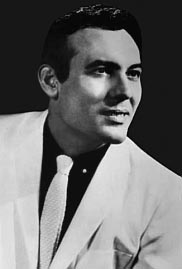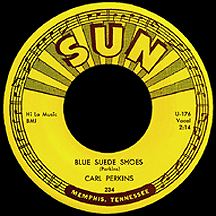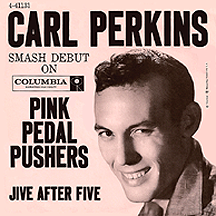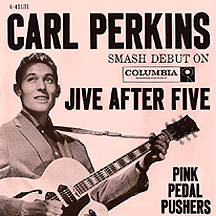CARL PERKINS
If any individual deserves to be called rock and roll's first cat, be it of the hillbilly-, rockabilly- or hep- variety, that person would certainly be Carl Perkins. After all, it was his massive 1956 hit that turned 'Let's Go, Cat!' into a national catchphrase that helped define a generation.
In the last week of February, 1956, Elvis Presley hit the pop singles charts for the first time (after some country success on Sun Records) with the RCA Victor single "Heartbreak Hotel." Several positions lower on the very same chart, "Blue Suede Shoes" made its premiere by Carl Perkins. The following week, Carl took a leapfrog jump over Elvis, and the race was on to conquer the charts. Elvis didn't rise to the top as quickly as you might expect...about a month later, with Carl in the lead, both songs broke into the top ten, then by mid-April, as we all know from our elementary school history lessons, Presley was number one. But Perkins hung in there, two or three notches below, for the next two months. At that point in time it seemed the "King of Rock and Roll" title was up for grabs, but of course the verdict was obvious shortly after. One thing is clear, though: both recordings are rock classics. An unfortunate, and still-lingering, after-effect is that Presley's slightly-later recording of "Blue Suede Shoes" is often associated with him over the original.
Perkins had a unique way of reacting to country music when he was young, seeing the unfettered aspect of a set of lyrics, imagining a rougher side that wasn't, in most cases, the intention of the writers or performers. His upbringing, not unlike many blues singers, was partly the cause for this perspective, being as he was from a family who worked hard to survive. Carl toiled long hours in the cotton fields near Tiptonville, Tennessee as early as age six, contributing the money he earned (as little as 25 cents a day) to the family for living expenses. In the early 1940s, at around age ten, his principal indulgence was listening to the Grand Ole Opry on Nashville's WSM, inspired by Roy Acuff and later Bill Monroe to sing and play guitar. After early attempts with a cigar-box-turned-homemade instrument, his father bought a well-worn Gene Autry model for a couple of dollars and Carl was able to immerse himself in his musical interest.
In 1947, when he was 14, the Perkins family moved to the Jackson, Tennessee area and opportunities to play in bars came up, so he figured why let his age hold him back? With older brother Jay, he began performing in the Jackson area, taking free drinks whenever they were offered, which apparently was often. Clayton Perkins was added on bass fiddle and the brother act became a trio, frequently spotted in area taverns singin', drinkin' and fightin', though not necessarily in that order. By the time he was 18, Carl had worked several day jobs, including stints at a mattress factory, dairy and bakery, while practicing his tough-guy style of country music before bar patrons in and around Madison County, going full time on the local tavern scene by 1953. Audition tapes sent to RCA Victor and Columbia Records were unsuccessful, but in '54 he caught Elvis's take on Monroe's "Blue Moon of Kentucky" on the radio, a song he had often performed, and decided it was time to head to Memphis to audition for the record label that seemed to have an open mind to his bluesy type of upbeat country music.
Sam Phillips of Sun Records was indeed the right guy to approach, and in the fall of 1954 Carl recorded his first single, "Movie Magg," a song he'd come up with several years before (about a girl he'd like to take to the picture show, if not for 'that doggone man and that double barrel behind the door that waits for Carl'). Released on Flip, another label Phillips owned, the song received enough exposure in the south for him to join Elvis on a couple of performance dates (another soon-to-be star Sun act, Johnny Cash and the Tennessee Two, was added shortly afterwards). Phillips switched Perkins to the Sun label for his second single, "Gone, Gone, Gone," planning to give him a bigger push, just as Elvis was leaving for greener pastures and much greater fame with RCA Victor.
Perkins has said the inspiration for "Blue Suede Shoes" came when he witnessed some guy berating a woman for stepping on his suede shoes (were they really blue, though?) and that image remains in the subconsciousness of pop culture. The record was the first million seller on Sun and speculation is that it could have been even bigger, perhaps hitting number one, had Carl and his brothers not been in an auto accident en route to New York for an appearance on NBC's Perry Como Show, delaying the opportunity to further expose the song.
Though he'd seen himself as a country type of artist, Perkins embraced the "rockabilly cat" image, following up his hit with other great singles in 1956. "Boppin' the Blues" celebrated the new blues-and-country sound with a rhythm beat, while "Dixie Fried" came straight from his background in the bars ('rave on, cats, he cried!') - drinkin', fightin' (with razor blades!), rockin' and keeping clear of the cops if possible. He wrote or co-wrote all of his songs at this time, and perhaps it was the graphic detail of the lyrics, based on his own experiences, that kept them from getting wider airplay.
After "Your True Love" in 1957, the records stopped hitting, and in 1958 Carl made the jump to Columbia (which had rejected him a few years earlier) hoping that, like Elvis, he would find greater fame with a larger label. Johnny Cash also moved to Columbia in 1958, leaning toward a more country style, reaping the benefits for many years to come, but Carl stayed on a rockabilly course with "Pink Pedal Pushers," commenting on an ankle-high-pants fashion fad with the hot rock and roll chicks of the time, and in '59, "Pointed Toe Shoes," about a late-'50s footwear trend.

Sustaining success was more difficult in the early-'60s, though penning "So Wrong," a hit in 1962 for Patsy Cline, helped. Still, by 1963 he was without a label deal and the drinking that had begun in his teens occupied most of his waking hours. Las Vegas welcomed him during this time and a tour of England with Chuck Berry in the spring of 1964 wound up exposing his music to a new, and very large, audience. He crossed paths with The Beatles between shows, just as they were creating a whirlwind across the globe (much as Elvis had done in 1956). Turns out the Fab Four counted themselves among his faithful fans and Ringo Starr, in particular, wanted to put his stamp on one or two Perkins classics. Carl gave his blessing, and "Matchbox" (the original flip of "Your True Love") was released as a single a few months later with Ringo on lead vocal, becoming one of the few Beatles hits not written by Lennon-McCartney or George Harrison. Around the end of the year, two more Perkins songs, "Honey, Don't!" (the "Blue Suede Shoes" flip, sung by Ringo) and "Everybody's Trying to Be My Baby" (with George singing the vocal) appeared on the group's next album (Beatles For Sale in the U.K. and Beatles '65 in the U.S.). Newfound attention had come Carl's way, together with a welcome financial windfall, and he was back on track.
In 1966 he signed with the small Dollie label, following his longtime friend and drinking buddy Johnny Cash on a purely country path, hitting the charts again (for the first time in over eight years) with "Country Boy's Dream" and "Shine, Shine, Shine." He went on tour with Cash, by this time a major star, and around 1968, through friendship and support, both were able to banish their demons: alcohol in Carl's case, and for Johnny a longstanding battle with harder drugs. Carl wrote one of Cash's biggest hits, "Daddy Sang Bass," a number one country smash. This success coincided with his return to Columbia Records and a top 20 country hit in 1969, "Restless," followed by many more years of recording and performing.
I had the pleasure and privilege of meeting Carl at a radio and record industry seminar in 1992. At a label-sponsored luncheon with several music artists in attendance, someone casually commented, "Oh look, there's Carl Perkins at that table over there." I said, "What???" at which moment I was no longer in control of my actions, as I walked straight over to the table and began to blabber on about him ("I have your original Sun records! Do you know how great you are?" and so on - I can't quote word for word what I said, because the whole thing was a surreal blur). I do remember everyone at the table laughing (at me or with me?) except Carl, who was smiling, shaking my hand and thanking me sincerely for the kind words. It could have been an embarrassing situation if I'd been in a state to recognize it as such (we were able to talk again later, after I'd regained my composure, and he related a couple of stories while we just hung out and had a good time). I've always seen myself as someone who can keep my cool around celebrities, they're just regular people, right? And that's usually how it is, just not in the case of Carl Perkins. But then how many opportunities does a person get to meet a legend?
NOTABLE SINGLES:
- Movie Magg - 1955
- Gone, Gone, Gone - 1955
- Blue Suede Shoes /
Honey, Don't! - 1956 - Boppin' the Blues - 1956
- Dixie Fried /
I'm Sorry, I'm Not Sorry - 1956 - Your True Love /
Matchbox - 1957 - Glad All Over /
Lend Me Your Comb - 1958 - Pink Pedal Pushers /
Jive After Five - 1958 - Pointed Toe Shoes - 1959
- Country Boy's Dream - 1966
- Shine, Shine, Shine - 1967
- Restless - 1969




